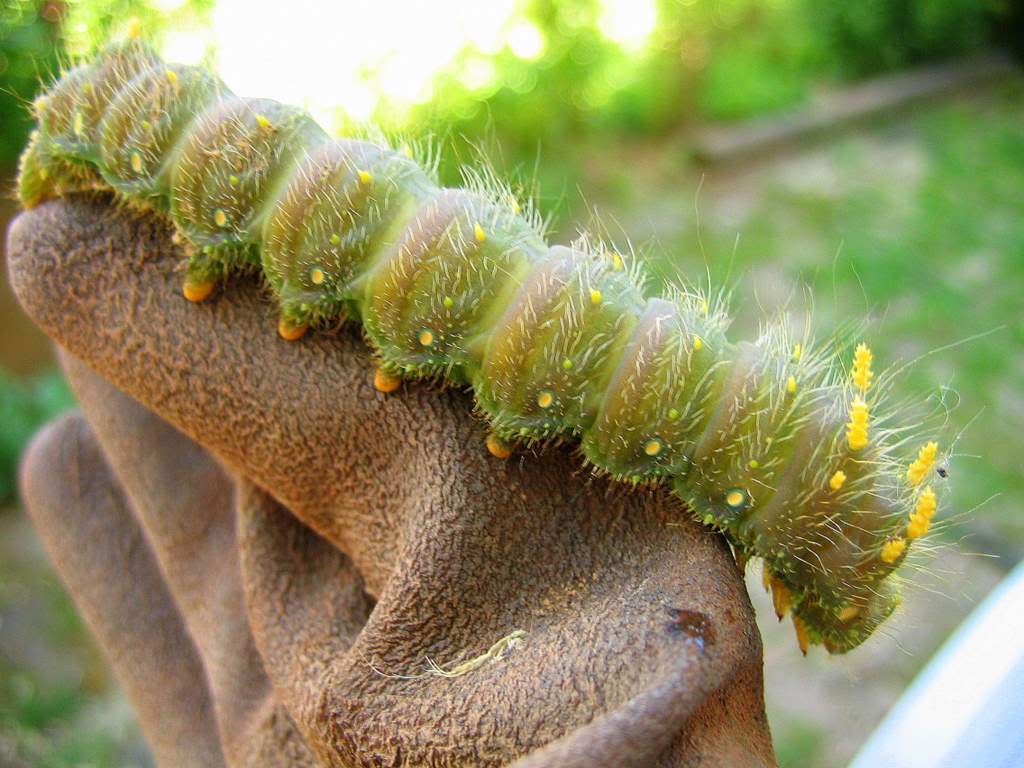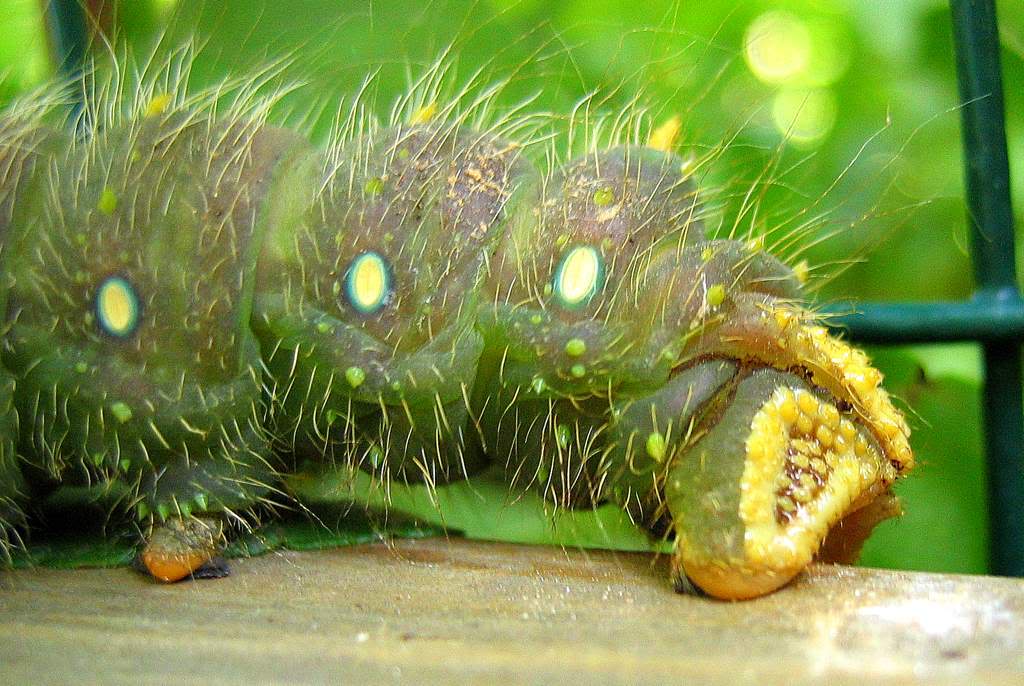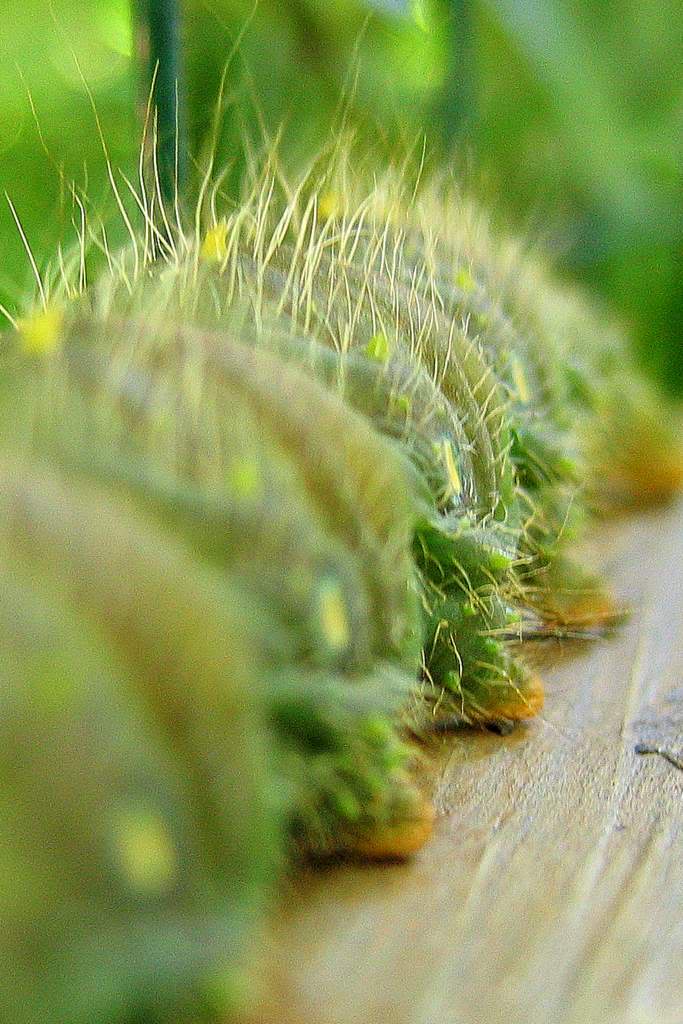I'm going way back into the garden photo archives for today's post, which is something I don't normally do except when I want to show how things have changed in my yard, or how some plant did in previous years. Today it's all in the past though, and it's not going to be pretty. Did you read yesterday's post about the insect photos from last summer? Did you get to the photo of the ants on the big dead caterpillar? Did you find it to be creepy? If so, was it the ants that bothered you, or the death aspect? Or maybe the giant caterpillar? If it was the caterpillar that you didn't like, then you're really not going to enjoy today's post.
I'm writing today about two large insects that I found in early fall in 2004. First up is this huge caterpillar, the largest I've ever seen.
I found this one making its way across my lawn in September. I've identified it as the caterpillar of the Imperial Moth. I never saw this in the beautiful huge moth form, just in the ugly, huge caterpillar form. Note that I was wearing my thick rubber-coated gloves to handle this guy. Not that it would have harmed me, but at that time I just couldn't let it crawl on my bare skin. Would I today? ... probably, but I'm not certain.
You can see this is quite a large caterpillar. When I found it on my lawn it was probably getting ready to burrow into the ground, as this species pupates underground. It spends the winter there, then in the spring it will emerge as a beautiful large moth.
Here's the head:
I'm not a fan of the yellow spiked horns. I don't think they will sting if touched, but I didn't want to find out.
Here's the tail:
The yellow ridges on the back look to me like plates of armor. Maybe they're just as soft and squishy as the rest of its body, but they look hard to me.
and here's the middle:
Did you know that the "legs" in the middle of caterpillars are not true legs? The only real legs are the three pairs of legs behind the head. The rest are "prolegs", including the rear "anal proleg". They work pretty well as legs, but they're not counted as part of the six legs that insects have.
Not the cutest caterpillar I've ever seen, that's for sure.
Now on to the second subject of today's post. If you thought the huge caterpillar was creepy, I've got good news and bad news. The good news is that the next one is not a huge caterpillar. The bad news is that it is instead a huge spider.
My wife found this guy in October 2004 in the parking lot of PetsMart. We guessed that it was an unwanted pet that somebody dumped there, or that it escaped. Luckily she had a container in the car and was able to "rescue" it and bring it home.
I believe it is a trapdoor spider, although I don't know the species. I'm also not sure if it would be able to survive our winters. I know that Missouri has trapdoor spiders, but that could be in the southern part of the state only. I decided to let it go in my garden anyway, as we were not going to keep it as a pet and didn't know what else to do with it.
This one wasn't huge -- maybe 2 inches long in total (including legs), but it was large enough to be noticed. Definitely large enough to be creepy, especially if you don't like spiders. Honestly I don't know how my wife was able to drive home knowing it was in the car with her. She is not a spider fan.
I didn't see this spider again after letting it go. I don't know if it found a good place to make its nest (in the ground, with a trapdoor of course), and don't know if it survived the winter. Since it's been six years, I expect it is no longer around.
I haven't really checked around for it though. It may still be back there somewhere. I don't know how shy these spiders are, although I suspect they're not very shy, as they are kept as pets (as are tarantulas).
To be honest, I'm glad both of these large "visitors" to my garden are not common. I'm not sure I could handle having these large, somewhat creepy critters around all the time.
(I promise this is the last insect/spider post for a few days at least.)










The spider in this tread is actually native to Missouri. It is actually a tube web spider (sphodros sp.) very closely related to trapdoor spiders.
ReplyDelete